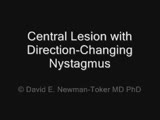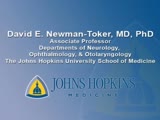The David Newman-Toker Neuro-Ophthalmology Collection contains great examination video and other resources relating to disorders of the brainstem and cranial nerves, including visual loss, double vision, and dizziness.
David Newman-Toker, MD, PhD, Associate Professor. Departments of Neurology, Ophthalmology & Otolaryngology, The Johns Hopkins University School of Medicine.
NOVEL: https://novel.utah.edu/
TO
1 - 25 of 4
| Title | Description | Type | ||
|---|---|---|---|---|
| 1 |
 |
Peripheral Lesion with Direction-Fixed Nystagmus | Typical spontaneous nystagmus associated with acute peripheral vestibular lesions is dominantly horizontal in vector and generally beats in one direction regardless of the eye position within the orbits. The nystagmus is usually present in the primary position, increases in gaze toward the direction... | Image/MovingImage |
| 2 |
 |
Central Lesion with Direction-Changing Nystagmus | With central causes of acute vestibular syndrome, it is not uncommon for the nystagmus to have a gaze-evoked component due to failure of gaze-holding circuits in the cerebellum or brainstem. In such instances, the nystagmus may reverse direction when the patient looks in the direction of the slow ph... | Image/MovingImage |
| 3 |
 |
Penlight-cover Test | Illustrates the penlight-cover test used to compare spontaneous nystagmus with and without fixation | Image/MovingImage |
| 4 |
 |
3-Component H.I.N.T.S. battery | Describes the 3-Component H.I.N.T.S. (Head Impulse, Nystagmus, Test of Skew) battery. A wide-angle view of the tests is followed by a close-up view. Please note that in the wide-angle view, the order of the tests is as would be typically conducted in practice (searching first for spontaneous nystagm... | Image/MovingImage |
1 - 25 of 4
